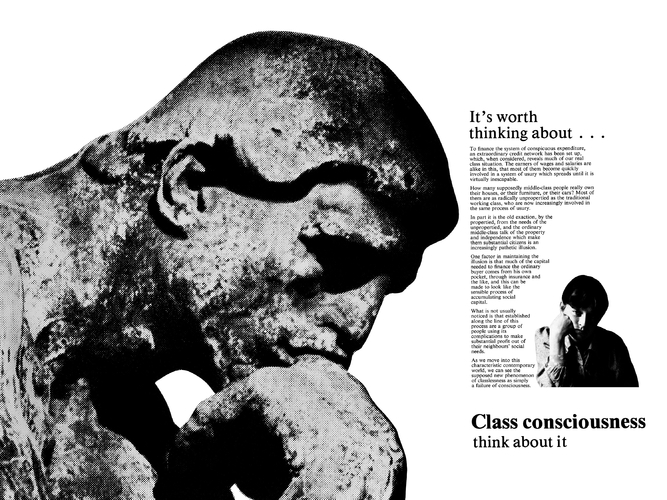
Exhibitions
14 October 2023 - 21 January 2024
Place(s)
Victor Burgin
Place(s) presents an ensemble of enigmatic works by internationally-known artist, theorist and teacher Victor Burgin (b. 1941, Great Britain).
This exhibition, which is taking place in parallel to That, a monographic exhibition at the Jeu de Paume in Paris, looks back at the decisive changes in Burgin’s approach between 1976 and 1984.
After a period during which he appropriated advertising images, he began taking
his own black & white photos that were informed by a street photography aesthetic. Combining words and images, his works focused on issues such as the class struggle and gender discrimination, providing a critical analysis of the politics of representation and the construction of ideology, while exploring the multiple interpretations of images.
The works on show produced between 1976 and 1984 bear witness to a period of artistic explorations anchored in the realities of society. They correspond to a desire to analyse and deconstruct the ways in which the world is represented, whether consciously or subconsciously. To this end, Victor Burgin made use of two powerful narrative tools: words and pictures. He developed a practice that culminated in the association of photos and texts in works that represented a counter discourse to accepted ideology. His strategy evolved according to his ongoing reflections on the question and new sources of inspiration.
From 1973 to 1976, in reaction to the sheer overabundance of photos at the time, Victor Burgin began appropriating advertising images, which were accompanied by texts written in a style that reproduced the rhetoric of advertising copy. Highlighting the contradictions of capitalist society, his works endeavoured to encourage spectators to look with a critical eye and develop class consciousness (Think about it, 1976 being a good example).
However, in a quest for greater freedom of action, Burgin began producing his own
images from 1976 onwards, looking to street photography for inspiration. He considered the latter as the means of photographic expression par excellence (see his series King’s Road 1976-84). Although he continued to juxtapose texts and images, their efficacy now relied on a play of associations that called on the subconscious. Burgin’s thinking, notably informed by Roland Barthes, had broadened its scope to integrate the lessons learned from psychoanalysis and fulfil the objective of revealing “the subconscious of the image”. This corresponded to a shift in focus from the representation of political reality to the politics of representation.
At the same time, another change took place in his choice of subject: until then, Burgin had concentrated on class inequality, but he now seized upon the question of gender inequality. This led him to tackle several closely interrelated issues, such as the patriarchy, the construction of subjectivity and sexuality (as illustrated in Zoo 78, 1978).
Finally, this period marked the start of the key role of locations in his work, mainly the urban environment, for example in his series In Lyon (1980) and In Grenoble (1981). As its title aptly suggests, this exhibition could also be compared to a stroll through a city
– its streets submerged in images. As we journey from one place to the next, we discover Burgin’s works that seem to exist in a dual environment in that they propose the discovery of both a physical and psychical space.
Since the late 1960s Victor Burgin’s work has established him as both a highly influential artist and a renowned theorist of the still and moving image.
Burgin first came to prominence in the late 1960s as one of the originators of Conceptual Art. In the 1970s his work consisted mainly of large framed photographic sequences, involving printed texts either juxtaposed with or superimposed on the image. At the beginning of the 1990s he turned towards digital video, but video from the point-of-view of photography – for example, Burgin is particularly interested in the relation between stasis and movement.
Throughout Burgin’s work there is a constant attention to this space ‘between’ the viewer and the object – to the ‘real’ world as seen through the prism of narrative, memory and fantasy.
His works are in the collections of renowned museums such as The Museum of Modern Art in New York and the Tate in London.
Victor Burgin is represented by Galerie Thomas Zander, Cologne; Galleria Lia Rumma, Milan and Naples, and Cristin Tierney Gallery, New York.
For more information, visit https://www.galeriezander.com/artists/66235/victor-burgin/works/
·Information
Press conference
Friday 13th October from 11 am
In the presence of the artists - Free shuttle from Paris (Place de la Bastille).
Reservation required. Please contact Francesco Biasi :
+33 (0)1 64 43 53 91 / francesco.biasi@cpif.net
Opening
Saturday 14th October at 3 pm
In the presence of the artists - Free shuttle from Paris (Place de la Bastille).
Reservation required.
+33 (0)1 70 05 49 79 / contact@cpif.net
·Acknowledgements
Victor Burgin and the Centre Photographique d’Île-de-France would like to thank the Thomas Zander gallery (Cologne) and the Grenoble Museum.
·In parallel
Exhibition at the Jeu de Paume Victor Burgin, That
From October 10th 2023 to January 28th 2024
The exhibition at Jeu de Paume features a selection of works from the 1970s-1980s, when Burgin worked with black and white photography, as well as works from the past two decades, when he starts to work with video. It will include some of his most recent works made with a “game engine” – software originally designed to create video games.

